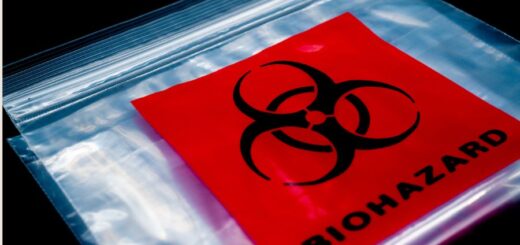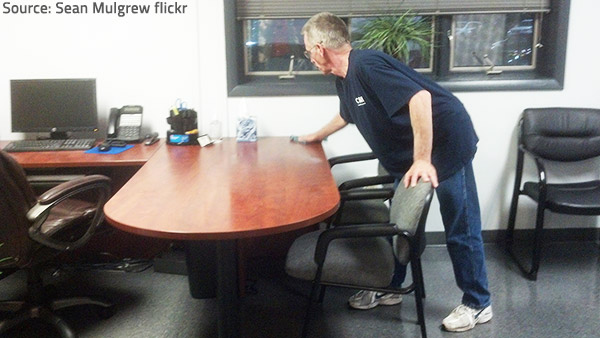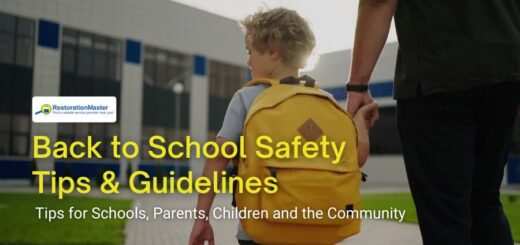6 Cleaning and Disinfection Tips for Commercial Buildings and Public Facilities
The coronavirus has upturned business and society. Commercial buildings and public facilities that are not routinely cleaned and disinfected can potentially be a public health threat. Managers of commercial properties are advised to follow recommended cleaning and disinfection tips to protect the public.
How COVID-19 Spreads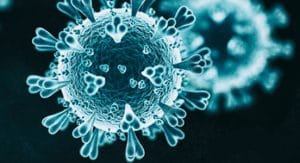
Although health officials still have a lot to learn about SARS-CoV-2 (the virus that causes Covid-19), it is now common knowledge that the virus primarily spreads through close person-to-person contact (within six feet). People who inhale infectious respiratory droplets can become sick with COVID-19.
Surfaces contaminated with the coronavirus can also spread COVID-19. People who handle contaminated objects and then touch their nose, eyes or mouth can send the coronavirus into their respiratory system, which leads to infectionInfection is the invasion and multiplication of harmful micr... More. Various surfaces can harbor the virus for certain periods of time.
COVID-19 on High-Touch Surfaces
Copper surfaces, like cabinet handles, can house the coronavirus for up to four hours. On cardboard, such as mail or commercial packaging, the coronavirus is viable for up to 24 hours. The coronavirus lives on nonporous surfaces, like stainless steel, for up to two to three days.
Surfaces consisting of the aforementioned materials are abundant in public facilities and commercial buildings. To protect public guests, employees, visitors, and customers from exposure to the coronavirus, it is critical that property owners clean and disinfect high-touch objects at least once a day.
Cleaning vs. Disinfecting Commercial Buildings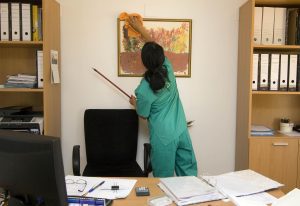
The acts of cleaning and disinfecting have two distinct purposes. Cleaning rids surfaces of visible dirt and grime, although the process does not kill germs. Disinfecting surfaces kills virusesViruses are microscopic infectious agents that can only repr... More, like the coronavirus, and other germs, thereby reducing the chances of contracting illnesses, like Covid-19.
In order to access the virusesViruses are microscopic infectious agents that can only repr... More flourishing under dirt, cleaning should be done first. A thorough commercial cleaning is followed by disinfecting with an EPA-approved disinfectantA disinfectant is a chemical substance used to kill or inact... More. Both processes must be performed to maintain a clean and sanitary space that is free from the threat of lingering coronaviruses.
Public facilities and commercial buildings that are open to the public are to be cleaned and disinfected. Daycare centers, schools and businesses are examples of areas where the general public gather outside of their households. In general, the following tips refer to nonhealthcare settings.
1. Wear PPE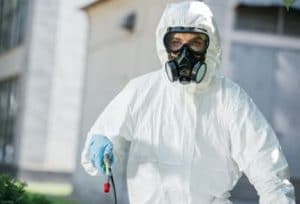
Although the risk of cleaning personnel’s exposure to Covid-19 is relatively low, cleaning crews are still advised to wear personal protective equipment (PPE)Personal protection equipment (PPE) is safety gear such as g... More while working. Disposable gloves and work uniforms should be worn while cleaning, disinfecting, and emptying trash cans.
The proper disposal of PPE is mandatory to avoid contaminationContamination is the presence of harmful or unwanted substan... More to the individual wearer and the surrounding environment. Immediately upon removal of the PPE, hands should be washed with soap and water for at least 20 seconds. Alternately, alcohol-based sanitizer may be used.
Adequate ventilationVentilation is the process of exchanging or circulating air ... More is necessary to protect cleaning personnel from the toxic fumes emanating from disinfectants and cleaners. Chemical products should never be mixed; combining products can unleash gases that are harmful to people when inhaled. Use the amounts recommended on product labels.
2. Use Approved Disinfectants
EPA-approved disinfectants that are proven to work against the coronavirus should be used to disinfect the surfaces within the commercial space. The Clorox Professional Products Company manufactures a range of effective ready-to-use disinfectants with active ingredients, such as hydrogen peroxide.
It is imperative that cleaning personnel follow the contact time (the number of minutes the solutionA solution is a homogeneous mixture of two or more substance... More remains visibly wet) as listed on the product label. Many Clorox products have a contact time of one to five minutes. Application methods are also listed on the label and should be followed.
3. Clean Soft Surfaces
PorousPorous describes a material that contains small openings or ... More surfaces may also be cleaned and disinfected with EPA-approved solutions that are manufactured for use with soft materials. Visible dirt should first be removed from carpeting, drapes, and rugs. If the soft items can be laundered, wash at the warmest setting and dry completely.
4. Disinfect Electronics
Hotels, schools, and offices are equipped with electronics, such as touchscreens, keyboards, ATM machines and remote controls. After removing visible contaminationContamination is the presence of harmful or unwanted substan... More, the equipment should be disinfected with alcohol-based wipes or sprays. Dry electronics completely to avoid the pooling of liquids.
5. Clean Hard Surfaces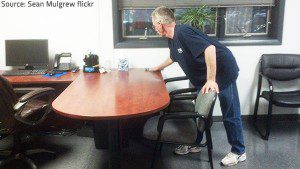
Clean hard surfaces with soap (or detergent) and water prior to disinfecting them. Focus on high-touch objects, such as doorknobs, faucet handles, toilets, light switches, elevator buttons and countertops. Schedule routine cleanings and disinfections throughout the day, especially in high-traffic areas.
6. Clean Indoor Air
Airborne coronavirus particles are thought to remain viable for several hours. A commercial building’s layout, HVAC system and ventilationVentilation is the process of exchanging or circulating air ... More capabilities affect the potential airborne spread of the virus. Clean air may be facilitated by increasing natural ventilationVentilation is the process of exchanging or circulating air ... More (opening windows) and filtering air.
Commercial building owners should supplement HVAC system ventilationVentilation is the process of exchanging or circulating air ... More with portable air cleaners. Although air cleaners alone will not improve air quality, these units are useful in areas that have limited ventilationVentilation is the process of exchanging or circulating air ... More. Also, direct airflow so that it does not blow directly from one individual to another.
Cleaning and disinfecting a commercial building or public facility on a routine basis takes enormous effort and time from cleaning personnel. When your existing coronavirus cleaning schedule becomes increasingly demanding as businesses start to reopen, count on a professional to provide effective disinfection services.
Work with a Commercial Cleaning and Disinfection Service
A reputable commercial cleaning service provides thorough cleaning and disinfection of your business property. Their skilled technicians are experienced in eliminating dangerous virusesViruses are microscopic infectious agents that can only repr... More, like the coronavirus, as well as H1N1, E. coli, tuberculosis, and salmonella.
These specialists utilize EPA- and CDC-approved cleaners and disinfectants and focus on cleaning and disinfecting high-touch surfaces as well as objects that are easy to miss. The cleaning crew’s priority is to ensure your commercial space is safe from the coronavirus.
Professional cleaning and disinfection services are beneficial in a wide range of commercial property types, from schools to hotels, gyms to warehouses and hospitals to nursing homes. All business owners are advised to take action to protect their customers, visitors, and employees from COVID-19.










